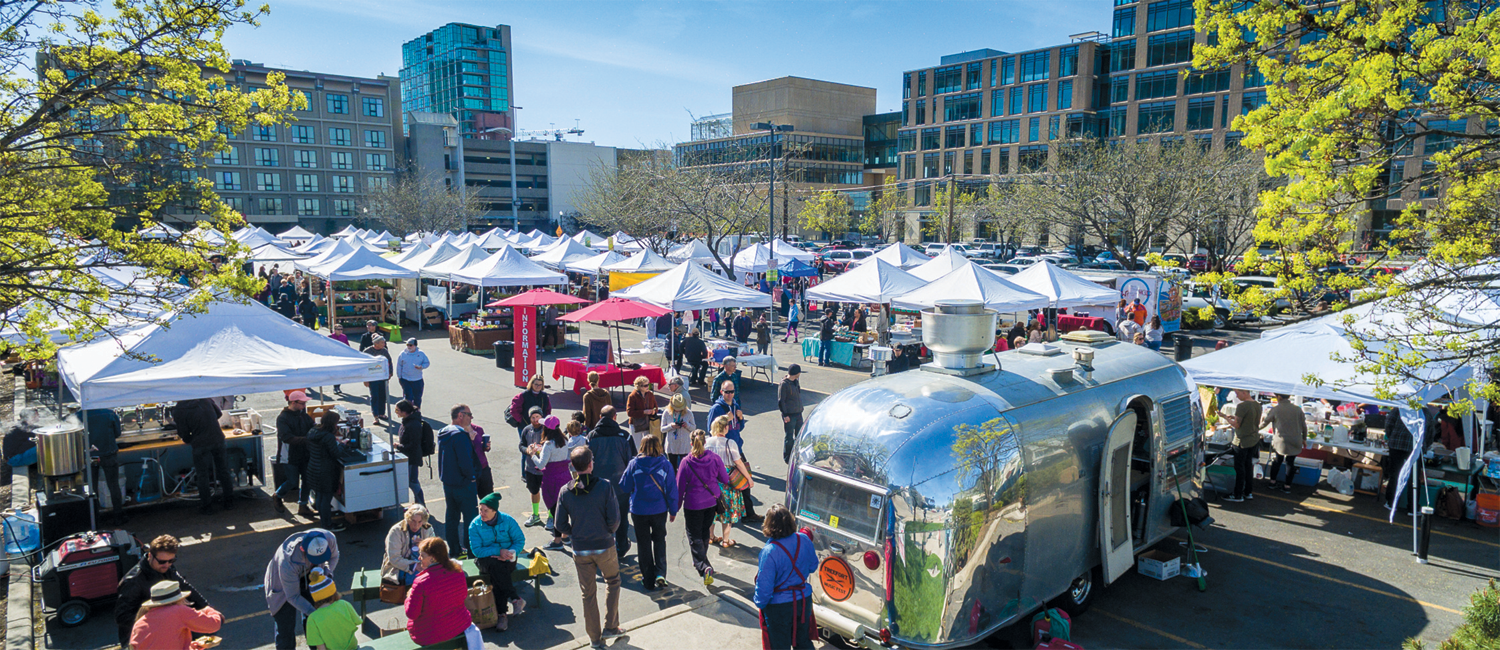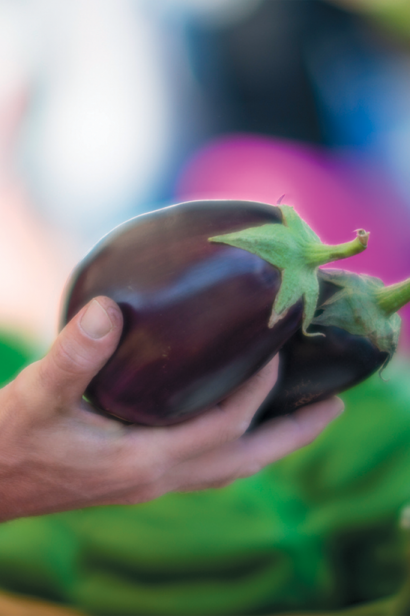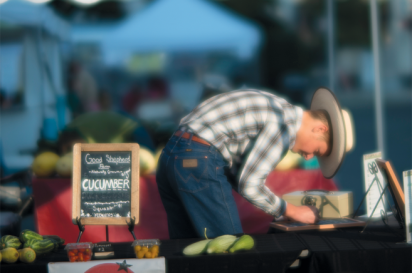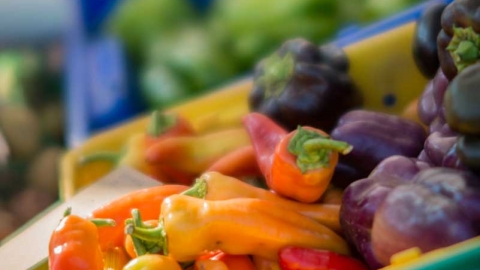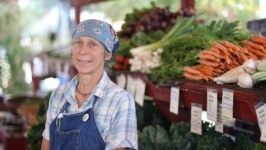Searching for a Full Time Future
Cindy Lampe felt that itch to start a new beginning. Her youngest son had just graduated from high school and Lampe found herself staring at an almost empty nest. She needed something new—a different direction, a fresh way to define her life.
“He does not need me to trail him around,” she said of her college-aged son, as she doled out samples of ginger-spiked granola on the last day of the 2017 Boise Farmers Market season. “So, I thought, ‘I need to do the next chapter for Cindy.’”
The California transplant began writing her latest life chapter one granola recipe at a time. And that new beginning started to taste sweet from Lampe’s vendor stall at the Boise Farmers Market.
“The nice thing about Idaho ... in California, everything has been done,” she said, noting the room for innovation she found in the local artisanal baked goods scene. How many people can turn out locally sourced batches of granola that have friends raving the way hers do, Lampe wondered. Where else can you buy handcrafted bags of granola with combinations like ginger and nut and chock-full of fruits from Weiser, Idaho?
Those thoughts birthed Lampe Granola, which has grown from her booth at the Market. Now Lampe is ready to boost production and she’s hoping the Market can continue to grow with her.
“I’ve made a lot of friends, but it wasn’t until I came to the Market that I felt like I was a part of Boise,” Lampe said.
The Boise Farmers Market began weaving itself into the fabric of downtown life in 2013 but, like Lampe, it’s ready for a new chapter and a place to plant some deeper roots. A permanent indoor market would give vendors a place to offer their goods year-round and the space they need to grow. Vendors and Market leaders already have planted some ideas about what that next chapter could look like. Lampe believes Boise is more than ready.
“I’ve been to other communities and I’ve thought, ‘We can do that here,’” Lampe said, sharing the same kind of enthusiasm for the Market’s future that she found from market organizers when she started hawking the granola idea.
Market Manager Karen Ellis “will tell you that you can do anything. Obviously, with her enthusiasm, I thought, ‘I can do that.’”
And when it comes to planting roots in a permanent location, Market directors say they can do that, too.
“We’re not saying no to anything right now,” said Market Board Secretary and Purple Sage Farms producer Mike Sommer. “We’re trying to get ideas and get a consensus on what our vendors want. Our vendors will be the ones that ultimately are footing the bill or are using the space, so we have to make sure that they are on board.”
Two days before Christmas the Market’s current winter indoor location at the corner of 8th and Fulton Streets bustled with the glitter of holiday shopping and the smell of baked goods. The repurposed warehouse gave vendors space and shoppers warmth, but the indoor days at that location can’t last forever, directors said. The market closed for the season on December 23 and won’t reopen outdoors on the corner of 10th and Grove Streets until April.
“It’s really a good fit for now because it allows our agricultural products to be sold regardless of the weather,” Janie Burns, Market board president, said of the current indoor space. But the Market feels the same growing pains that plague the rest of Boise and its renting population.
“People are highly rating a permanent spot because right now we are nomadic. We’re in one spot downtown but nothing is for certain. We need certainty as farmers. We need to know year-to-year what’s going to happen,” Sommer said.
The Boise Farmers Market’s locations—both the outdoor lot and the downtown warehouse—have a future that’s as tenuous as any other low-rent tenant around Boise. Landlords can always jack up rent, sell their property or put the real estate to an entirely different use.
Boise’s latest chapter of booming growth made vacant spaces in the downtown core an endangered commodity.
“That is one of the last open parking lots in the downtown core,” Burns said of the outdoor location. “At some point, the owners of that property will be offered a barrel full of money and we would have to find a new summer home as well. So, we should start looking sooner rather than later.”
“It’s extremely worrisome,” Burns said of the uncertainty that comes with running a nomadic market.
She said producers depend upon certainty that requires long-term plans for when and where the market operates. A permanent location for year-round, indoor produce sales would give producers that certainty, Burns said.
A permanent market could also encourage expanded produce options and vendor business growth. With a long growing season and indoor production, Boise offers an ideal locale for a year-round market, Burns said. “We have found that when you expand the season of the market in any direction, farmers fill that space. Farmers would see that space and think ‘What could I grow?’”
Plus, consumers eat year-round. And livestock don’t pay much attention to market hours.
“The farmers market pulls you into the cycle of the seasons; there’s something special about eating with the cycle of the land,” said Mia Crosthwaite of Feathers and Horns dairy.
The year-round idea drew praise from vendors who say their shoppers like to go to the same place at the same time and sometimes peel away when the market changes to its indoor location in the fall. But what a year-round market would look like and the amenities it would provide remain up for debate. Some would like to see a commercial kitchen and space for a bakery or coffee shop. Others are happy with what they’ve already got.
A swanky space with lots of amenities isn’t something Gail Ansley really needs after driving across stretches of desert from Picabo Desert Farm in Richfield to deliver her goat-milk yogurt and cheese to the market.
A communal kitchen ranks at the top of many vendors’ wish list, but that resource may not fit everyone’s needs, Ansley said. The U.S. Department of Agriculture requires meat producers to undergo rigorous inspections and some say that could make it difficult for vendors that process meat to share communal kitchens that must undergo USDA inspection to meet sanitation standards.
Ansley added, “If you are a meat vendor, the commercial kitchen isn’t going to do you one iota. They’re under the USDA so it’s never going to help them. We all have different needs.”
The Boise Farmers Market isn’t the first to look for ways to take cover and serve vendors’ unique needs. The operators of the Capital City Public Market have their eyes on the possibility of moving some vendors into the quasi indoor space near the elevators at the Capitol Terrace parking garage. But that would only give 10 vendors additional space, said Mona Warchol, executive director of the Capital City Public Market.
“We don’t have any space to go indoors because we’re so big. There’s not really a space that’s large enough to take 130 vendors,” she said.
The Hawkins Company plans to remodel the Capitol Terrace building and garage this spring, as first reported by BoiseDev.com.
But indoor space can sometimes make or break a vendor’s decision to set up shop. Lampe said the elements almost kept her from hawking granola at the Boise Farmers Market.
“I didn’t think I would like the [Boise Farmers Market] that much because I’m not really into the rain, the wind, the hot, sticky, the cold. I didn’t think it would be my thing,” Lampe said.
Vendors may have another indoor option with plans to create a public market space in vacant shops at the Boise Spectrum. Owner and operator Nicholas Jones wrote in a blog that the Chow Public Market and Eatery, slated to open in May, aims to become the only all locally owned and customer-centric public market of its size and kind in the United States.
“So, what makes the Chow Public Market and Eatery so unique?” Jones wrote. “It’s our focus on local food options exclusive to Boise and connecting people with a sense of discovery.”
Sommer said organizers hope to make progress over the next couple of years in deciding what the Boise Farmers Market needs and how it would operate. That’s where things get complicated, directors said. Would the Market own the space or would a nonprofit take ownership and lease the property? Would the Market turn over the operations of its educational outreach programs and community services like the EBT program to another nonprofit organization? Those issues are all part of the planning process.
“Right now, we are in the process of figuring out what we want and what we need and what the differences are between those,” Sommers said. “We’ve got a 30,000-foot view and will zoom in as we go,” he added. “It’s going to be challenging to get everyone on the same page.”
Whatever that first page of the next chapter looks like, it’s slated to unfold into a story with some deep roots.
“We’ve been having ideas sessions and right now the sky is the limit,” Sommers said.


